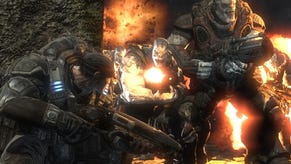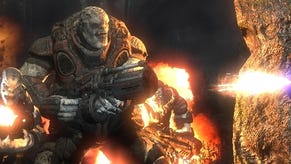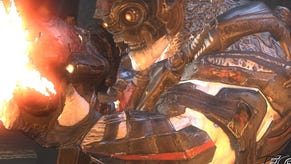Gears of War: Judgment Preview: Shifting up the Gears
Judgment's free-for-all reflects the title's broader freeform intensity.
Gears of War is no longer just a game about killing monsters - in the multiplayer space, anyway. Showing off a new free-for-all deathmatch mode for the upcoming series prequel Gears of War: Judgment, Epic's showcase at PAX Prime 2012 gave a glimpse into a seemingly alternate future that once was a franchise impossibility: COG killing COG.
Regardless of its multiplayer status, a human versus human deathmatch mode may seem like a drastic step away from the traditionally Human-on-Locust violence that has permeated the Gears series. But rather than a sharp twist to a core philosophy, design director Cliff Bleszinski says Judgment's free-for-all mode was created out more out of practical convenience for players.
"When you join a server in traditional Gears multiplayer, you don't know if you're going to wind up on COG or Locust," he says, highlighting players' desire to often play with specially unlocked characters or pre-order skins. "By doing human-on-human, we can basically say if you want to play as Baird in the multiplayer when you play on a server you can always be the Baird that you're grinding and unlocking."
"If you're going to grind, there are some cool Locust but generally speaking you want an identifiable human thing," Bleszinski adds. "We're not going to put a cowboy hat on a Locust. We're not going to put a football jersey on a Locust."
It's a small shift away from players' randomly assigned team placement that underscores several nips and tucks Epic and People Can Fly have done to tighten up Judgment's design in both the single player campaign and multiplayer. Free-for-all's straightforward approach to deathmatch has just what you would probably expect - namely every-man-for-himself survival, ammo caches and, without the option for teamwork, no bleeding out - yet its streamlining is more directly tied to perhaps less thought about details.
Though Judgment's free-for-all still feels like the hulking Gears of the past, slight tweaks to the control scheme make the flow of combat faster and more frenetic. You can instantly cycle through your weapons on the fly, for instance, with a dedicated button for offhanded grenades that yields much faster access than the comparatively clunky weapons select of previous titles. It's a microcosm of the intensity that Judgment re-introduces into the Gears' design, using a dynamic gameplay system to spawn enemies at random points.
"We're not as heavy on scripted sequences this time. I love those as much as the next guy, but we're now more about the dynamic spawn system, more about throwing something different at the player."
"We're not as heavy on scripted sequences this time," Bleszinski says. "I love those as much as the next guy, but we're now more about the dynamic spawn system, more about throwing something different at the player."
Bleszinski feels mechanics should be "meaty," taking precedence over an abundance of scripted scenes that are only fun to watch once.
"A game that's more replayable is a better game overall even if you never replay it," he says.
While I naturally didn't encounter any Locust hordes during my brief hands-on time with free-for-all, I was still could get a sense of what Bleszinski is talking about. The designer's new "Play your way" philosophy - a recent company mantra advocating emergent player experiences across both Judgment and the upcoming survival sandbox title Fortnite - is subtly apparent in environmental nuances like the ability to run off ledges, opening up maps to a new layer of mobile strategy.
Stalking my competition through Library, a brightly lit interior stage with ornate architecture and strategically placed bookcases, I was able to move more freely around the map, though less hardcore competitive players may not even notice the change. Still, with the modified controls it's easier to swap between weapons (even if I mostly stuck with my tried-and-true "sprint-and-saw" Lancer tactic - gutting a COG is no less cartoony than a Locust, either).
There's a balance between creating more hardcore gameplay and expanding accessibility for a series, Bleszinski says.
"You will die a little bit in this game," he says. "The thing is, when you play hardcore it will actually be a more hardcore mode. Normal's going to be more normal and casual will be absolutely casual and insane will be absolutely insane. The difficulty will match with its description far better than any other Gears game."
Bleszinski also emphasizes how important it is to bring the Locust back to their terrifying roots by focusing on the sheer horror of a full-on assault from a large enemy force.
"When you turn around and there's a mauler on top of you, you panic. And that's a good feeling in a game," he says. "Because when you're done with the combat encounter you're wiping the sweat off your brow and your friends are high fiving each other, saying 'yeah, we did that.' We want to get back to that as opposed to you just being Rambo and steamrolling through all of them."
The change-up seemed necessary following Gears 3, which Bleszinski says should have been a little more intense, both in design as well as in the entry's Lambent enemies. "If I could go back in time, I'd give the Lambent more personality so that they were more fun to fight. Maybe with a little less exploding in your face," he says.
In any case, Bleszinski seems intent on bringing Judgment thematically full circle with its concentrated action and a more cerebral script penned by screenwriter Rob Auten and Extra Lives author Tom Bissell. It's another essential step in bringing Gears back in line with its original vision, he says.
"We're not going to be like The Old Man and The Sea all of a sudden, and [Tom and Rob] can't immediately shift gears and act like this is the smartest Gears ever", Bleszinski says. "That was never the intent from the beginning. Let the game be a little more about what really matters, which is war, the locust being scary and what's at stake."








